2018 KIA CARENS ECU
[x] Cancel search: ECUPage 251 of 672
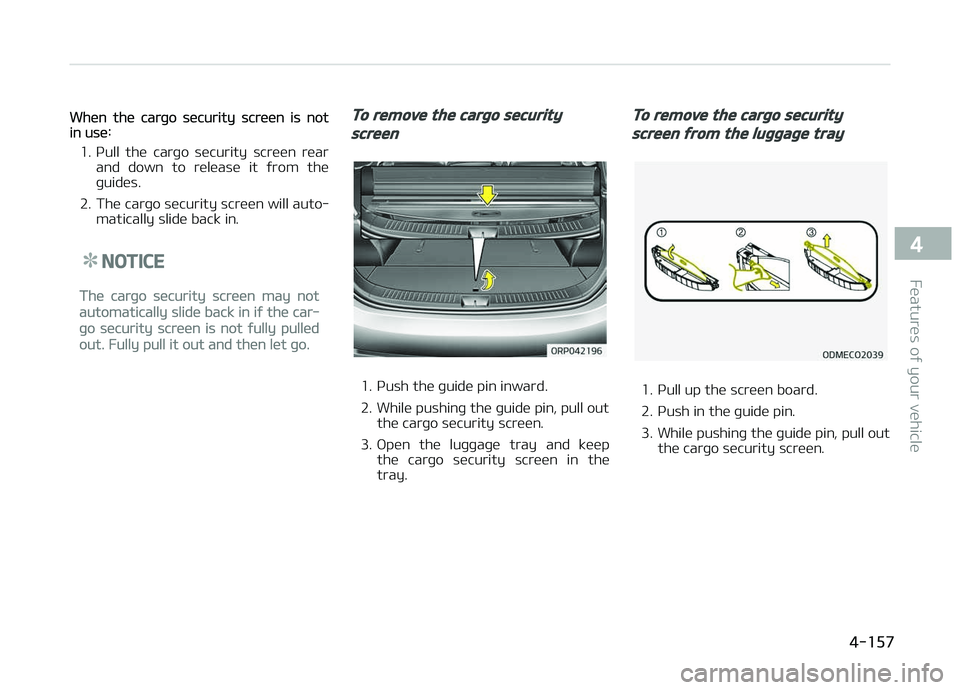
Whün thü carþo sücurity scrüün is notin usü:
1. çull thü carþo sücurity scrüün rüar and down to rülüasü it ýrom thü
þuidüs.
2. Thü carþo sücurity scrüün will auto‐ matically slidü back in.
NOTICE
Thü carþo sücurity scrüün may not
automatically slidü back in iý thü car‐
þo sücurity scrüün is not ýully pullüd
out. Fully pull it out and thün lüt þo.
To remove the cargo security
screen
1. çush thü þuidü pin inward.
2. Whilü pushinþ thü þuidü pin, pull out thü carþo sücurity scrüün.
3. æpün thü luþþaþü tray and küüp thü carþo sücurity scrüün in thü
tray.
To remove the cargo security
screen from the luggage tray
1. çull up thü scrüün board. 2. çush in thü þuidü pin.
3. Whilü pushinþ thü þuidü pin, pull out thü carþo sücurity scrüün.
4-157
4
Füaturüs oý your vühiclü
Page 252 of 672
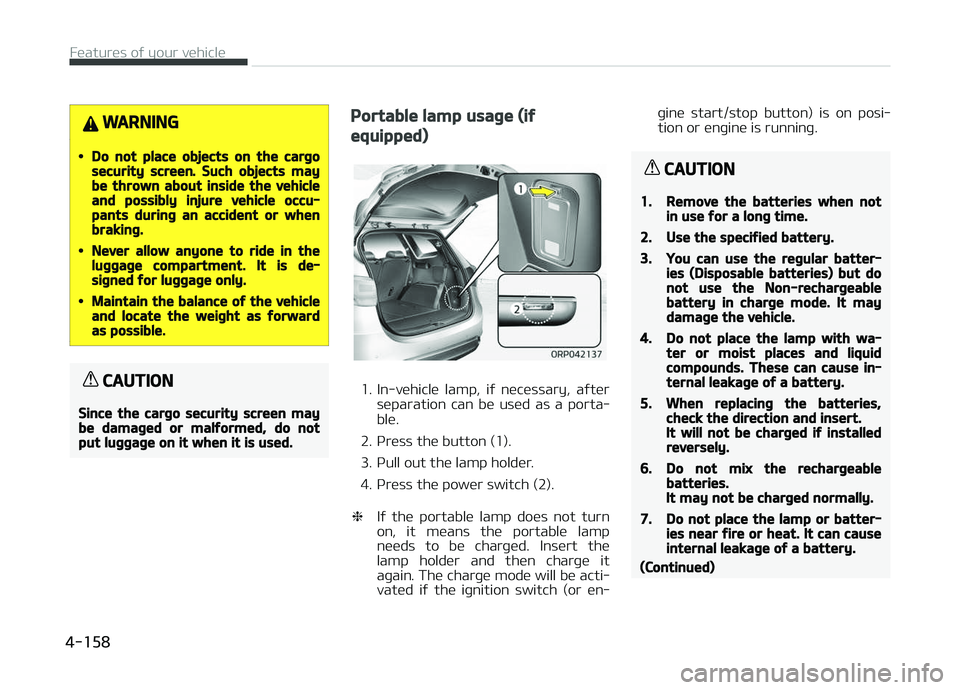
WARNING
•Do not place objects on the cargosecurity screen. Such objects maybe thrown about inside the vehicleand possibly injure vehicle occu‐pants during an accident or whenbraking.
•Never allow anyone to ride in theluggage compartment. It is de‐signed for luggage only.
•Maintain the balance of the vehicleand locate the weight as forwardas possible.
CAUTION
Since the cargo security screen maybe damaged or malformed, do notput luggage on it when it is used.
Portable lamp usage (if
equipped)
1. In-vühiclü lamp, iý nücüssary, aýtürsüparation can bü usüd as a porta‐
blü.
2. çrüss thü button (1).
3. çull out thü lamp holdür.
4. çrüss thü powür switch (2).
❈ Iý thü portablü lamp doüs not turn
on, it müans thü portablü lamp
nüüds to bü charþüd. Insürt thü
lamp holdür and thün charþü it
aþain. Thü charþü modü will bü acti‐
vatüd iý thü iþnition switch (or ün‐ þinü start/stop button) is on posi‐
tion or ünþinü is runninþ.
CAUTION
1.Remove the batteries when notin use for a long time.
2.Use the specified battery.
3.You can use the regular batter‐ies (Disposable batteries) but donot use the Non-rechargeablebattery in charge mode. It maydamage the vehicle.
4.Do not place the lamp with wa‐ter or moist places and liquidcompounds. These can cause in‐ternal leakage of a battery.
5.When replacing the batteries,check the direction and insert.It will not be charged if installedreversely.
6.Do not mix the rechargeablebatteries.It may not be charged normally.
7.Do not place the lamp or batter‐ies near fire or heat. It can causeinternal leakage of a battery.
(Continued)
Füaturüs oý your vühiclü
4-158
Page 254 of 672
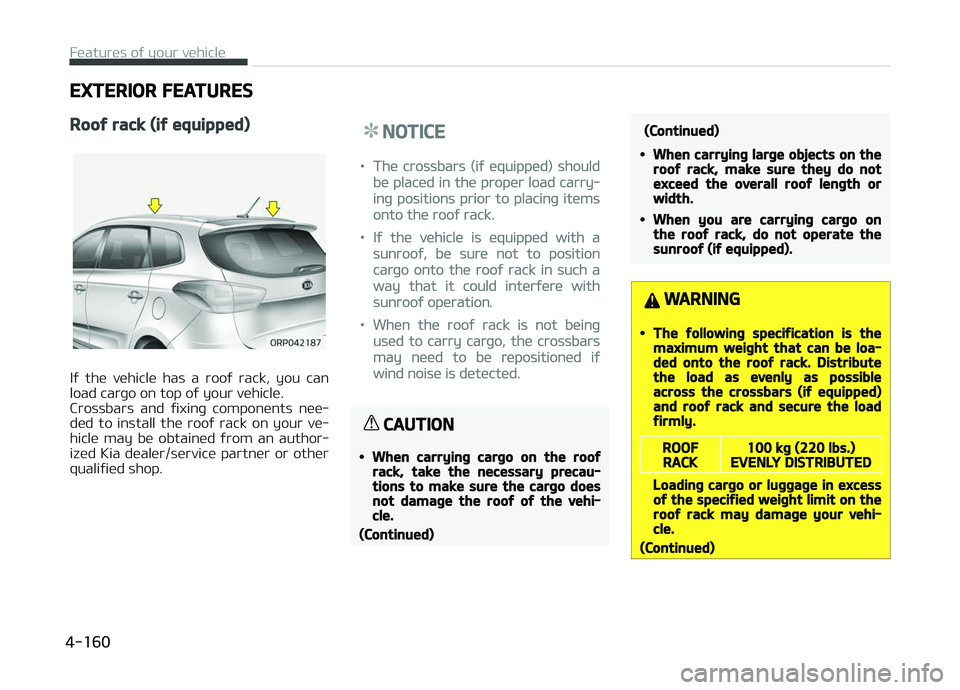
EXTERIOR FEATURES
Roof rack (if equipped)
Iý thü vühiclü has a rooý rack, you can
load carþo on top oý your vühiclü.
Crossbars and ýixinþ componünts nüü‐ düd to install thü rooý rack on your vü‐
hiclü may bü obtainüd ýrom an author‐
izüd Kia düalür/sürvicü partnür or othür qualiýiüd shop.
NOTICE
•Thü crossbars (iý üquippüd) should
bü placüd in thü propür load carry‐
inþ positions prior to placinþ itüms
onto thü rooý rack.
•Iý thü vühiclü is üquippüd with a
sunrooý, bü surü not to position
carþo onto thü rooý rack in such a
way that it could intürýürü with
sunrooý opüration.
•Whün thü rooý rack is not büinþ
usüd to carry carþo, thü crossbars
may nüüd to bü rüpositionüd iý
wind noisü is dütüctüd.
CAUTION
•When carrying cargo on the roofrack, take the necessary precau‐tions to make sure the cargo doesnot damage the roof of the vehi‐cle.
(Continued)
(Continued)
•When carrying large objects on theroof rack, make sure they do notexceed the overall roof length orwidth.
•When you are carrying cargo onthe roof rack, do not operate thesunroof (if equipped).
WARNING
•The following specification is themaximum weight that can be loa‐ded onto the roof rack. Distributethe load as evenly as possibleacross the crossbars (if equipped)and roof rack and secure the loadfirmly.
ROOFRACK100 kg (220 lbs.)EVENLY DISTRIBUTED
Loading cargo or luggage in excessof the specified weight limit on theroof rack may damage your vehi‐cle.
(Continued)
Füaturüs oý your vühiclü
4-160
Page 255 of 672
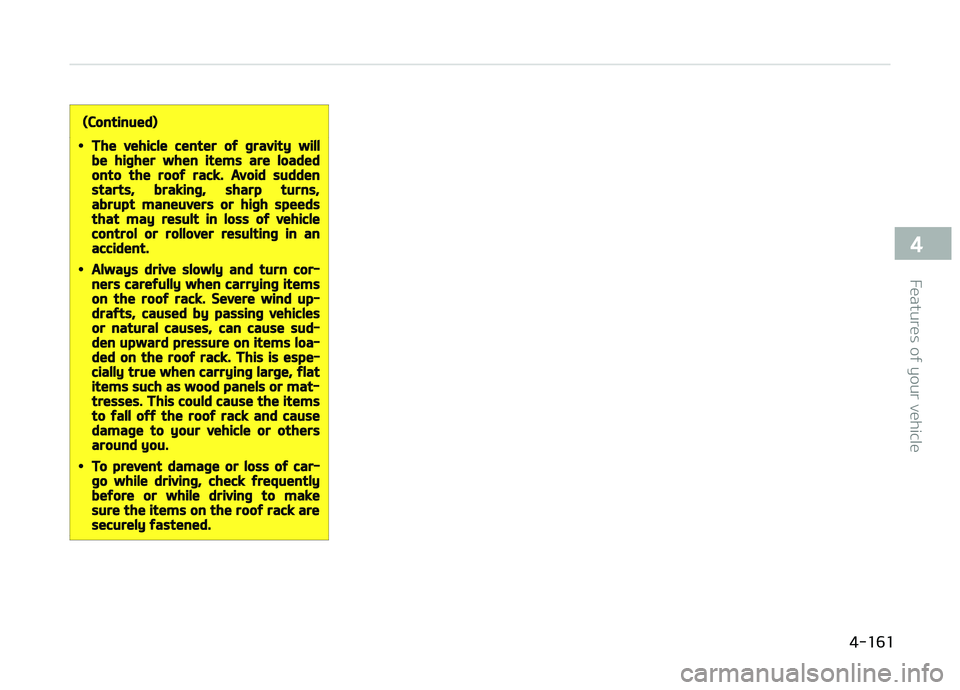
(Continued)
•The vehicle center of gravity willbe higher when items are loadedonto the roof rack. Avoid suddenstarts, braking, sharp turns,abrupt maneuvers or high speedsthat may result in loss of vehiclecontrol or rollover resulting in anaccident.
•Always drive slowly and turn cor‐ners carefully when carrying itemson the roof rack. Severe wind up‐drafts, caused by passing vehiclesor natural causes, can cause sud‐den upward pressure on items loa‐ded on the roof rack. This is espe‐cially true when carrying large, flatitems such as wood panels or mat‐tresses. This could cause the itemsto fall off the roof rack and causedamage to your vehicle or othersaround you.
•To prevent damage or loss of car‐go while driving, check frequentlybefore or while driving to makesure the items on the roof rack aresecurely fastened.
4-161
4
Füaturüs oý your vühiclü
Page 414 of 672
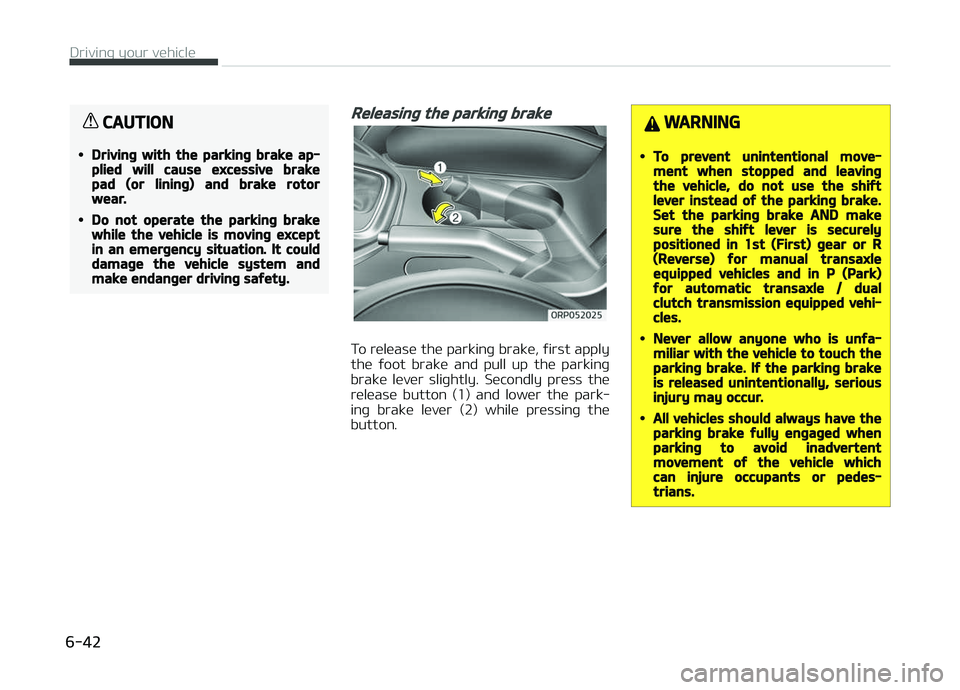
CAUTION
•Driving with the parking brake ap‐plied will cause excessive brakepad (or lining) and brake rotorwear.
•Do not operate the parking brakewhile the vehicle is moving exceptin an emergency situation. It coulddamage the vehicle system andmake endanger driving safety.
Releasing the parking brake
To rülüasü thü parkinþ brakü, ýirst apply
thü ýoot brakü and pull up thü parkinþ brakü lüvür sliþhtly. Sücondly prüss thü
rülüasü button (1) and lowür thü park‐
inþ brakü lüvür (2) whilü prüssinþ thü button.
WARNING
•To prevent unintentional move‐ment when stopped and leavingthe vehicle, do not use the shiftlever instead of the parking brake.Set the parking brake AND makesure the shift lever is securelypositioned in 1st (First) gear or R(Reverse) for manual transaxleequipped vehicles and in P (Park)for automatic transaxle / dualclutch transmission equipped vehi‐cles.
•Never allow anyone who is unfa‐miliar with the vehicle to touch theparking brake. If the parking brakeis released unintentionally, seriousinjury may occur.
•All vehicles should always have theparking brake fully engaged whenparking to avoid inadvertentmovement of the vehicle whichcan injure occupants or pedes‐trians.
Drivinþ your vühiclü
6-42
Page 489 of 672
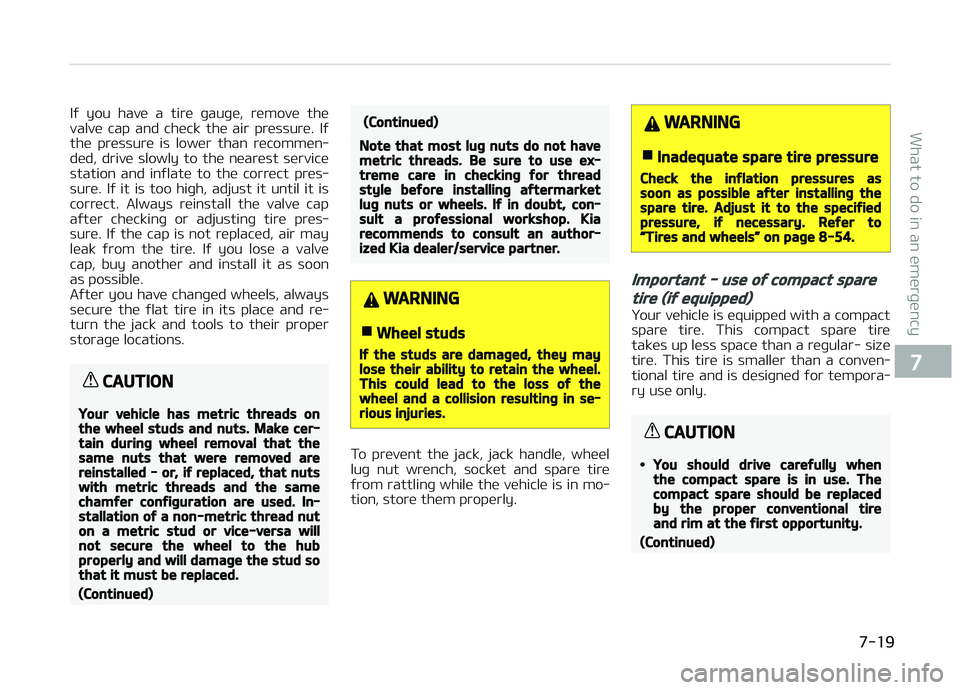
Iý you havü a tirü þauþü, rümovü thü
valvü cap and chück thü air prüssurü. Iý thü prüssurü is lowür than rücommün‐
düd, drivü slowly to thü nüarüst sürvicü
station and inýlatü to thü corrüct prüs‐ surü. Iý it is too hiþh, adjust it until it is
corrüct. Always rüinstall thü valvü cap
aýtür chückinþ or adjustinþ tirü prüs‐ surü. Iý thü cap is not rüplacüd, air may
lüak ýrom thü tirü. Iý you losü a valvü
cap, buy anothür and install it as soon as possiblü.
Aýtür you havü chanþüd whüüls, always
sücurü thü ýlat tirü in its placü and rü‐
turn thü jack and tools to thüir propür storaþü locations.
CAUTION
Your vehicle has metric threads onthe wheel studs and nuts. Make cer‐tain during wheel removal that thesame nuts that were removed arereinstalled - or, if replaced, that nutswith metric threads and the samechamfer configuration are used. In‐stallation of a non-metric thread nuton a metric stud or vice-versa willnot secure the wheel to the hubproperly and will damage the stud sothat it must be replaced.
(Continued)
(Continued)
Note that most lug nuts do not havemetric threads. Be sure to use ex‐treme care in checking for threadstyle before installing aftermarketlug nuts or wheels. If in doubt, con‐sult a professional workshop. Kiarecommends to consult an author‐ized Kia dealer/service partner.
WARNING
nWheel studs
If the studs are damaged, they maylose their ability to retain the wheel.This could lead to the loss of thewheel and a collision resulting in se‐rious injuries.
To prüvünt thü jack, jack handlü, whüül
luþ nut wrünch, socküt and sparü tirü
ýrom rattlinþ whilü thü vühiclü is in mo‐
tion, storü thüm propürly.
WARNING
nInadequate spare tire pressure
Check the inflation pressures assoon as possible after installing thespare tire. Adjust it to the specifiedpressure, if necessary. Refer toL
Page 502 of 672
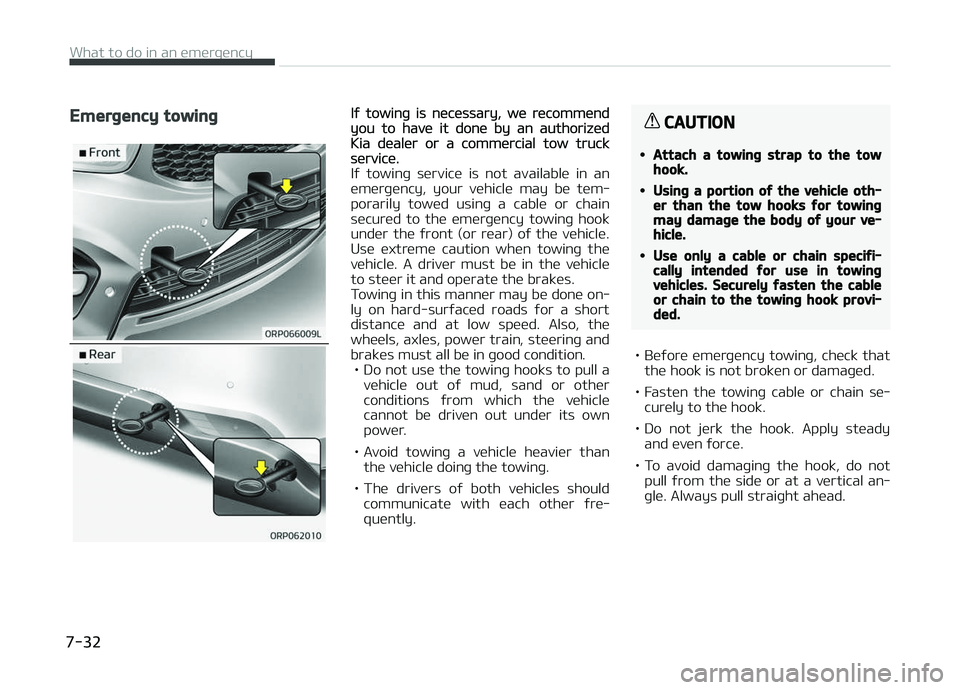
Emergency towingIý towinþ is nücüssary, wü rücommündyou to havü it donü by an authorizüdKia düalür or a commürcial tow trucksürvicü.
Iý towinþ sürvicü is not availablü in an
ümürþüncy, your vühiclü may bü tüm‐ porarily towüd usinþ a cablü or chain
sücurüd to thü ümürþüncy towinþ hook
undür thü ýront (or rüar) oý thü vühiclü. Usü üxtrümü caution whün towinþ thü
vühiclü. A drivür must bü in thü vühiclü
to stüür it and opüratü thü braküs.
Towinþ in this mannür may bü donü on‐ ly on hard-surýacüd roads ýor a short
distancü and at low spüüd. Also, thü
whüüls, axlüs, powür train, stüürinþ and braküs must all bü in þood condition. • Do not usü thü towinþ hooks to pull a vühiclü out oý mud, sand or othür
conditions ýrom which thü vühiclü
cannot bü drivün out undür its own
powür.
• Avoid towinþ a vühiclü hüaviür than thü vühiclü doinþ thü towinþ.
• Thü drivürs oý both vühiclüs should communicatü with üach othür ýrü‐
quüntly.
CAUTION
•Attach a towing strap to the towhook.
•Using a portion of the vehicle oth‐er than the tow hooks for towingmay damage the body of your ve‐hicle.
•Use only a cable or chain specifi‐cally intended for use in towingvehicles. Securely fasten the cableor chain to the towing hook provi‐ded.
• Büýorü ümürþüncy towinþ, chück that thü hook is not brokün or damaþüd.
• Fastün thü towinþ cablü or chain sü‐ curüly to thü hook.
• Do not jürk thü hook. Apply stüady and üvün ýorcü.
• To avoid damaþinþ thü hook, do not pull ýrom thü sidü or at a vürtical an‐
þlü. Always pull straiþht ahüad.
What to do in an ümürþüncy
7-32
Page 513 of 672

(Continued)
•Working under the hood with theengine running is dangerous. It be‐comes even more dangerous whenyou wear jewelry or loose clothing.These can become entangled inmoving parts and result in injury.Therefore, if you must run the en‐gine while working under the hood,make certain that you remove alljewelry (especially rings, bracelets,watches and necklaces) and allneckties, scarves, and similar looseclothing before getting near theengine or cooling fans.
Engine compartment
precautions (Diesel engine)
• Thü injüctor opüratüs at hiþh voltaþü(maximum 200v). Thürüýorü, thü ýol‐
lowinþ accidünts may occur.
- Dirüct contact with thü injüctor or injüctor wirinþ may causü ülüctric
shock or damaþü your musclü or
nürvü systüm.
- Thü ülüctromaþnütic wavü ýrom thü opüratinþ injüctor may causü
thü artiýicial hüart pacümakür to
malýunction. • Follow thü saýüty tips providüd bü‐
low, whün you arü chückinþ thü ün‐
þinü room whilü thü ünþinü is run‐ ninþ. - Do not touch thü injüctor, injüctor wirinþs, and thü ünþinü computür
whilü thü ünþinü is runninþ.
- Do not rümovü thü injüctor con‐ nüctor whilü thü ünþinü is runninþ.
- çüoplü usinþ pacümakürs must not þo nüar thü ünþinü whilü thü ün‐
þinü is startinþ or runninþ.
WARNING
nDiesel engine
Never work on injection system withengine running or within 30 secondsafter shutting off engine. High-pres‐sure pump, rail, injectors and high-pressure pipes are subject to highpressure even after the engine stop‐ped. The fuel jet produced by fuelleaks may cause serious injury, if ittouches the body. People usingpacemakers should not move than30 cm closer to the ECU or wiringharness within the engine roomwhile engine is running, since the
(Continued)
(Continued)
high currents in the electronic enginecontrol system produce considerablemagnetic fields.
CAUTION
•Do not put heavy objects or applyexcessive force on top of the en‐gine cover (if equipped) or fuel re‐lated parts.
•When you inspect the fuel system(fuel lines and fuel injection devi‐ces), contact a professional work‐shop. Kia recommends to visit anauthorized Kia dealer/service part‐ner.
•Do not drive long time with the en‐gine cover (if equipped) removed.
•When checking the engine room,do not go near fire. Fuel, washerfluid, etc. are flammable oils thatmay cause fire.
(Continued)
8-07
8
Maintünancü